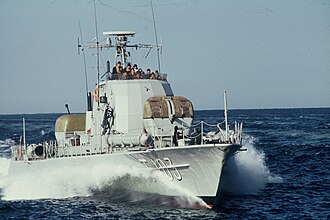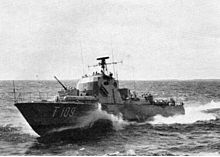Pleiad class (1953)
|
|
|
|---|---|

|
|
| class | Pleiad |
| Type | Torpedo speedboat |
| Type boat | HMS Pleiad T102 |
| units | 11 |
| Technical specifications | |
| displacement | 175 tons (use) 155 t (construction) |
| length | over all 48 meters, KWL 45.2 m |
| width | 5.8 m |
| Draft | 1.6 m |
| Speed: | 37.5 kn (~ 70 km / h) |
| crew | 33 |
| drive | 3 propellers 3 diesel engines MB 518/3 with 3,000 HP each |
| Armament |
|
The Plejad class was a speed boat class with torpedo armament of the Swedish Navy (there as "Torpedbåten" classified). 11 boats were built by the German Lürssen shipyard from 1953 to 1957. These remained in service until the mid-1970s. The class was named after the first boat put into service, all other boats were named after stars.
history
The Pleiad class was seen in Sweden as a replacement for the first Pleiad class of torpedo boats, which were built in the years 1905-1910 and decommissioned during the Second World War or shortly thereafter. The new Pleiad boats were considerably larger and more powerful than the previous torpedo boats and their task was clearly differentiated from the even smaller MTB (Motortorpedbåten) that were also available .
The Plejad class served as a model for further developed Swedish self-made buildings ( Spica class ). You were in active service until 1973. In 1977 and 1981 the boats were sold. Some were used for civil purposes after the sale, e.g. B. T103 Polaris as a three-masted sailing yacht and T106 Rigel as a work boat with crane superstructure.
An almost identical boat was delivered by Lürssen in 1951 for testing purposes. This HMS Perseus (T101) was never used in the fleet service, but only used as a carrier, primarily for engine testing. In 1967 the boat was taken out of service.
The Pleiad class already showed features of the German Jaguar class , which was built for the German Navy from 1957 .
construction
The Plejad-boats were as round frame - Verdrängerboote constructed of shipbuilding steel. They were of three mechanically supercharged diesel engines MB 518 from Mercedes-Benz powered with 3000 hp at 1720 rpm, the boats with a maximum speed of 37.5 knots awarded. The exhaust gases were discharged laterally below the water line to reduce noise.
Armament
Four of the six torpedo tubes , which represented the main weapon of the boats, were mounted in pairs on the stern at an angle to the side of the rear gun post. The other two were mounted straight ahead in the direction of travel on the forecastle on both sides of the bow gun position. No replacement torpedoes could be carried. The wire-guided Torped 14 was used from the late 1950s and the Torped 61 from the mid-1960s .
The two 40 mm anti-aircraft guns were initially mounted in open positions in front of and behind the bridge structure . At the end of the 1950s, they were covered with plastic hoods against the weather. The guns were aimed centrally over an optical target column m / 1948.
The boats were equipped with two types of flares to illuminate the confusing operational area during the long periods of darkness in the far north. The four larger ones with a diameter of 103 mm were attached to the bridge structure in two launch racks. The twelve-fold rocket launcher with 57-mm rockets stood right in the stern of the boat.
In addition, rails for laying mines could be installed.
Boats of the class
- HMS Pleiad (T102)
- HMS Polaris (T103)
- HMS Pollux (T104)
- HMS Regulus (T105)
- HMS Rigel (T106)
- HMS Aldebaran (T107)
- HMS Altair (T108)
- HMS Antares (T109)
- HMS Arcturus (T110)
- HMS Argo (T111)
- HMS Astrea (T112)
See also
Individual evidence
- ↑ Tidskrift i Sjöväsendet , January 1959, p 38
- ↑ Roderick Klintebo: Det svenska ubåtsvapnet 1904-2004 . In: Forum navales script series . tape 9 . Literatim, Stockholm 2004, ISBN 91-973075-3-X .
- ↑ Launched in 1956, taken out of service in 1977 and sold to a private buyer together with Antares (T109).
- ↑ 1977 withdrawn and sold together with Altair (T108) to a private interested party.

